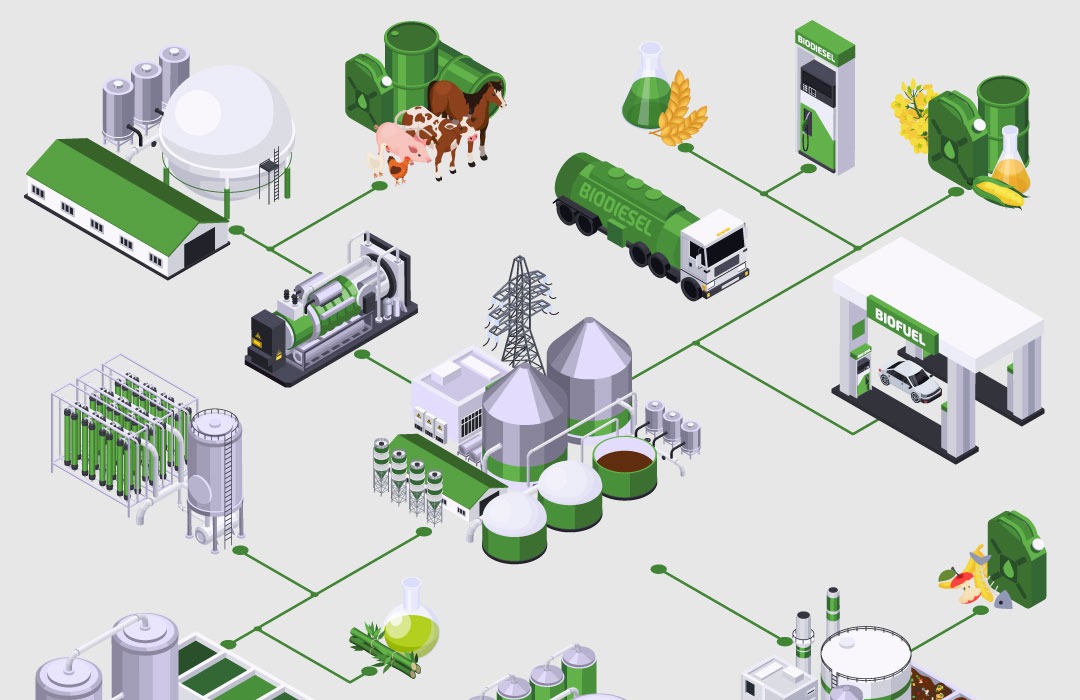Economic benefits of anaerobic digestion
Energy cost savings
Anaerobic digestion (AD) systems generate biogas that can replace conventional fossil fuels, reducing energy bills for farms, municipalities, and industrial facilities. By converting organic waste into usable energy, operators can achieve significant cost savings over time.
Revenue from byproducts
Beyond energy, AD produces digestate—a nutrient-rich fertilizer that can be sold or used on-site. Some systems also capture carbon credits, adding another revenue stream. These byproducts contribute to a circular economy and enhance project profitability.
Long-term return on investment (ROI)
While initial costs can be high, AD systems offer long-term ROI through energy savings, byproduct sales, and environmental incentives. With proper planning and funding, projects can become profitable within 5–10 years.
Main applications across industries
AD technology is versatile and applicable across sectors:
Agriculture
Manure and crop waste are ideal feedstocks for farm-based digesters.
Food processing and municipal waste
Organic waste from cities and factories can be transformed into energy.
Industrial energy recovery
Factories can use AD to manage waste and generate on-site power.
Key costs in anaerobic digestion projects
Capital Expenditures (CAPEX)
CAPEX includes the cost of digester construction, feedstock handling systems, biogas purification units, and energy conversion equipment. Depending on scale, costs range from $500,000 to $20 million.
Operational Expenditures (OPEX)
OPEX covers labor, maintenance, feedstock logistics, and monitoring systems. Efficient design and automation can reduce these costs over time.
Financing and funding challenges
Securing capital is often the biggest hurdle. Many projects struggle to attract investors due to technical complexity and long payback periods.
Policy and market incentives
Government subsidies and grants
Many governments offer grants for renewable energy projects, including AD. These can cover up to 30% of CAPEX, making projects more viable.
Tax incentives and renewable energy credits
Operators may qualify for tax deductions, accelerated depreciation, and renewable energy credits, improving financial performance.
Fundraising consulting services for anaerobic digestion projects
The role of fundraising experts
Projects RH specializes in fundraising consulting services for AD projects. Their team prepares investor-ready materials including information memorandums, pitch decks, and teasers. They help clients navigate funding challenges and connect with suitable investors.
Matching investors with sustainable energy projects
Projects RH works with strategic partners to match AD projects with ESG-focused investors. Their process includes financial modeling, documentation, and investor engagement.
Understanding Information Memorandums for Anaerobic Digestion Projects
Creating an effective information memorandum is crucial for securing investment in anaerobic digestion projects. A well-prepared memorandum outlines the project’s potential financial returns and sustainability impact, making it an essential tool for attracting the right investors.
Case Study Approach: Urbenex BioEnergy and Projects RH
Urbenex BioEnergy installs anaerobic digesters on farms and landfills without requiring capital from hosts. They manage construction and operations, converting methane into CNG and repurposing digestate as fertilizer.
Farmers earn ~$200,000 annually for manure supply. Projects RH supports Urbenex by preparing information memorandums, pitch decks, and teasers, ensuring investor readiness and ESG alignment. This partnership demonstrates how AD can deliver environmental and financial value.
Challenges and risk management in the economics of anaerobic digestion
Market price fluctuations for energy
Biogas prices can vary based on market demand and policy changes. Long-term contracts and diversification help mitigate this risk.
Feedstock supply risks
Seasonal availability and quality of feedstock can affect performance. Blending and storage strategies are essential.
Regulatory and compliance costs
Permitting and environmental compliance can be costly and time-consuming. Expert guidance helps navigate these challenges.
Future outlook of anaerobic digestion economics
Technological advancements reducing costs
AI-based feedstock optimization, modular digesters, and carbon capture integration are lowering costs and improving efficiency.
Expanding global demand for renewable energy
Climate goals and energy security concerns are driving demand for biogas and digestate products.
Opportunities for innovative financing models
Green bonds, carbon credit trading, and ESG-linked loans are emerging tools to fund AD projects.
FAQ




